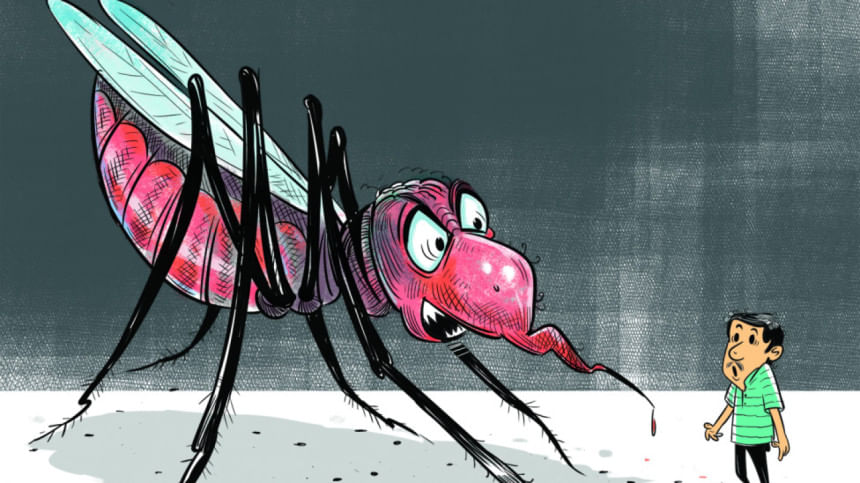Humanity is losing its war against an impossible predator

From Beowulf's Grendel to Camus' plague-stricken Oran, literature has long grappled with terrors that haunt humanity—monsters, contagion, and invisible adversaries that test the limits of survival. Yet, no antagonist has been so enduring, so real, and yet so underestimated as the mosquito.
Even as science races to outpace the mosquito's insidious advance, a quieter failure shadows our response—not one of technology, but of imagination. Despite being the deadliest predator in human history, the mosquito remains strikingly underrepresented in both classical and modern literature. When it does appear—whether in Aesop's fable The Lion and the Mosquito, Virgil's Culex, or Spenser's The Faerie Queene—it is cast as a petty irritant, a moral aside, never a true antagonist. Even Thoreau, in Walden, admired its persistence, likening its hum to "Homer's requiem," yet still relegated it to background noise.
This absence is telling. Unlike lions or metaphysical plagues, the mosquito kills without spectacle—its victims slip away in silence, far from poetry and pageantry. That silence has enabled a deeper neglect, blinding us to a predator of mythic scale and slow, unrelenting lethality. Analogous to the warning etched on the rear-view mirror of the very transport we are driving, the mosquito's presence looms closer than we think—trailing us, gaining ground, and poised to prey.
In The Mosquito: A Human History of Our Deadliest Predator, Timothy C Winegard chronicles how this tiny insect has (re)shaped human destiny—from decimating Alexander the Great's army to undermining colonial forces in the American South, influencing the outcomes of wars and the rise and fall of empires. Winegard estimates that mosquitoes have been responsible for the deaths of some 52 billion people, nearly half of all humans who have ever lived. This insect has stalked humanity across time and space, asserting its power not with sound (sans buzzing) and fury, nor with a bang or a whimper, but with veritable torrents of fever and blood. And yet, in the third decade of the 21st century, it is not we who are winning the war; but the mosquito, deftly keeping us on a slippery slope, turning each step forward into one back.
Climate change, unchecked urbanisation, and growing insecticide resistance have converged to give mosquitoes a decisive edge. Diseases once in retreat, such as malaria, dengue, chikungunya, Zika, are resurging. The dream of eradication, fervently pursued in the mid-20th century, has faded into a tenuous and fraying truce.
In 2024, South Asia witnessed its worst dengue epidemic in history. Bangladesh and India recorded thousands of deaths as hospitals overflowed. Latin America faced simultaneous outbreaks of dengue, Zika, and chikungunya, while malaria re-emerged in southern Europe. According to the World Health Organization (WHO) World Malaria Report, the WHO African Region recorded 246 million malaria cases and 569000 malaria deaths, in 2023 alone—most of them children under five. Meanwhile, in the United States, dengue is surging in Puerto Rico, the US Virgin Islands, and parts of Florida and Texas. West Nile virus and Eastern equine encephalitis are expanding, and local malaria cases have returned in Florida and Texas—the first in two decades. Bangladesh, ground zero for the 2024 dengue crisis, offers a stark preview of what happens when mosquito prowess meets state paralysis: hospitals overflow, science lags, and death becomes routine.
The mosquito thrives on inequality. It does not discriminate in whom it bites, but it kills disproportionately—affecting the poor, the displaced, and those without access to clean water, sanitation, or healthcare. Winegard captures this paradox: mosquitoes are democratic biters but undemocratic killers. And yet, the world's attention remains fleeting. Funding for mosquito-borne disease prevention spikes during crises and vanishes in the aftermath. The structural drivers—climate injustice, urban poverty, and decaying public health infrastructure—remain unaddressed.
Still, humanity has not stood still. Across the globe, scientists, governments, and public health advocates have mounted increasingly innovative counteroffensives. In sub-Saharan Africa, drone-assisted larval spraying has dramatically reduced mosquito populations. In Rwanda, larval density dropped by 93.3 percent, while malaria incidence also declined significantly. Ghana and Sierra Leone are testing AI-enabled drones that identify breeding sites and deliver larvicides with precision.
Asia is scaling smart surveillance systems. Singapore's Dragonfly robot scans traps and uses deep learning to identify species with 82 percent accuracy in real-time. India's Smart Mosquito Surveillance System (SMoSS) relays mosquito density data to municipal teams for intervention. Microsoft's project Premonition combines robotic traps, drones, and DNA sequencing to detect mosquito-borne pathogens.
Genetic strategies have opened new fronts. In Brazil, genetically modified Aedes aegypti males are released to mate with wild females, producing non-viable offspring and suppressing local populations by up to 96 percent. Wolbachia-based methods, which use bacteria to block virus transmission, have cut dengue cases by over 75 percent in Indonesia and Australia.
Other tactics include the Sterile Insect Technique (SIT), where irradiated males are released en masse to reduce breeding. Supported by the IAEA and FAO, SIT is being tested from Réunion Island to Valencia. China's Photon Matrix laser prototype uses LiDAR to detect and kill mosquitoes mid-air—30 per second—without harming other insects. Spatial repellents like SC Johnson's Mosquito Shield, approved by the EPA, are proving effective in humanitarian settings.
Yet, these innovations risk becoming tools of the privileged. High costs, infrastructure demands, and patent restrictions limit their use in low-income regions. Bed nets remain the primary defence in many areas, unevenly distributed and often compromised by resistance.
This is not just a scientific challenge. It is a political and moral reckoning. A coordinated response must integrate classical tools, such as source reduction, repellents, education, with high-tech innovations. Surveillance must inform health dashboards. Gene technologies must be ecologically reviewed, transparently governed, and locally approved.
Above all, interventions must address the inequality mosquitoes exploit—poverty, overcrowding, poor infrastructure. The mosquito adapts quickly. So must we, through inclusive innovation and sustained investment.
Winegard ends his book with a sobering truth: we may never eliminate mosquitoes. But we can alter the terms of coexistence. We must treat them not as nuisances, but as existential threats, on par with pandemics and climate change.
The hum in the dark is not just an insect's wingbeat. It is a historical echo and a future warning. If we fail to act with foresight and equity, the battle will not end in a dramatic crescendo, but in slow attrition: more childhood deaths, more failed pregnancies, more disrupted lives, and deeper global divisions. The mosquito did not merely accompany human history; it stalked it. To ignore its power is folly. To confront it requires not just scientific progress, but moral clarity and political will. In the end, humanity may not lose to a nuclear bomb or artificial superintelligence, but to an impossible predator we still underestimate: the mosquito.
In Steinbeck's Of Mice and Men, dreams are undone by forces just beyond reach—misunderstood, underestimated, and ultimately lethal. The mosquito belongs to a similar register of fatal irony. It is small, almost laughable in scale, yet it kills with impunity, thriving on our negligence and inequality. As we confront this ancient adversary, we must shed our illusions—of technological supremacy, of immunity by wealth, of victory by indifference. The story of mosquitoes and men is not over yet. But unless we confront its protagonist with urgency, imagination, and justice, it may end as Steinbeck's tale does: with a quiet devastation we saw coming all along, but still failed to stop.
Dr Faridul Alam is a retired academic and writes from New York City, US.
Views expressed in this article are the author's own.
Follow The Daily Star Opinion on Facebook for the latest opinions, commentaries and analyses by experts and professionals. To contribute your article or letter to The Daily Star Opinion, see our guidelines for submission.

 For all latest news, follow The Daily Star's Google News channel.
For all latest news, follow The Daily Star's Google News channel. 










Comments